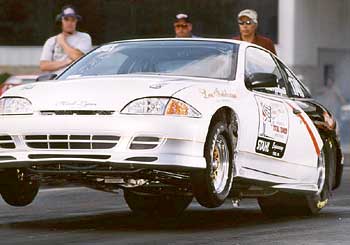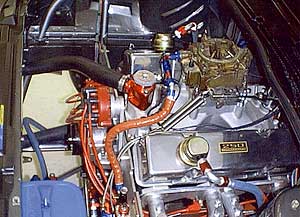![]() met Jere Stahl in the early
'60s when he raced at Connecticut Dragway and from that day on Jere and Bill
"Grumpy" Jenkins influenced my thinking about the hows and whys of building
a racecar. I began racing Modified Production in the mid-sixties in a 1966 A/MP
427 Chevelle. That car, which ran right on the national record, was sold in
New Mexico on the way home from the '68 Winternationals.
met Jere Stahl in the early
'60s when he raced at Connecticut Dragway and from that day on Jere and Bill
"Grumpy" Jenkins influenced my thinking about the hows and whys of building
a racecar. I began racing Modified Production in the mid-sixties in a 1966 A/MP
427 Chevelle. That car, which ran right on the national record, was sold in
New Mexico on the way home from the '68 Winternationals.
 Under
Stahl's tutelage and with Grump's help, I built a '69 Camaro that was sponsored
by Valenti Chevrolet in Wallingford, CT. The Camaro fell right into the newly
formed Pro Stock category. I ran the Camaro in the late '60s and early '70s,
and did pretty well, winning consistently on a local level. We had the first
nine-second Camaro in the northeast, and we were running with the best of them
nationally. The Camaro ran a best of 9.40, which was pretty good at the time.
Under
Stahl's tutelage and with Grump's help, I built a '69 Camaro that was sponsored
by Valenti Chevrolet in Wallingford, CT. The Camaro fell right into the newly
formed Pro Stock category. I ran the Camaro in the late '60s and early '70s,
and did pretty well, winning consistently on a local level. We had the first
nine-second Camaro in the northeast, and we were running with the best of them
nationally. The Camaro ran a best of 9.40, which was pretty good at the time.
I lived in California for nearly 20 years and stayed away from the dragstrips except for an occasional visit when my old friend Grumpy was in town. Then my dad became ill and went into a nursing home in 1993 and I returned to the East Coast to help my mother through a difficult time. It wasn't long before I was reunited with my old friend and many-time national record holder, Joe "Moon" DeLorenzo. Joe was notorious with his small blocks (alien to me) and one fateful day Joe, Jon Girardi and I went to the Nationals at Englishtown. I reconnected with Stahl and the story of this car began.
I originally wanted to build a Camaro, but Joe, being more astute about what was
going on in Super Stock, ran some weight-to-horsepower numbers and said we would be much better off using a Cavalier as the platform for this venture. If we built a stick shift Cavalier, it would be the first rear wheel drive stick shift conversion in competition.
I resisted for a bit; who would want to build a front wheel drive compact conversion? Certainly not me! Then I went to a Chevy dealership and crawled around under a Cavalier and the possibilities became quite apparent.
Joe DeLorenzo was originally supposed to build the engines, but he developed cancer and he didn't live long enough to see the Cavalier make a pass down the quarter-mile. Joe's input and help was indeed missed.
The Grump was in the middle of his Pro Stock engine development program and
didn't have enough manpower available to devote to my project.
 Gary Hettler (the winningest Super Stock engine builder in the country) built two 250-hp 327 c.i. engines. |
Jere put me in touch with engine builder Gary Hettler. Red Roberts at McLeod Industries set us up with two Soft Lok clutch assemblies and George Maxwell at Jerico got us two four-speed transmissions. Jere recommended a RacePak V-500 data recorder and which "bells and whistles" should be on our system.
Our wish-list was very long, but I decided that if the rulebook didn't say
you couldn't do it and if we could get it approved by NHRA, then I wanted it
in the Cavalier. There were many items on my list that NHRA rejected. This "'70s"
approach to building the racecar would come back to bite me in the butt big-time
later.

| The Cavalier was built by Mark Lynn of Jerry Bickel Race Cars. | The paint job caused no problems. |
The project was considerably more labor intensive than JBRC had anticipated and the delays associated with getting NHRA's approval on every aspect of the new car's construction extended the process even longer. Bickel assigned the project to Mark Lynn, who had done most of JBRC's prototype chassis for 17 years. Lynn built the car in his own home shop.
In June 2003, the Cavalier was complete and ready to race. For the amount of money I had invested in the Cavalier, I could have bought two Bickel Pro Stockers.
We took the Cavalier to a divisional event at Atco, NJ for inspection. Tech inspectors Bob Lang and Curt LaShure had my trick Cavalier spread out all over the scale area. The interior and dash were out and the hood and trunk were open. As Bob and I stood side by side looking over the car, he said, "Len, your Cavalier is really nice and it's really safe. Unfortunately, it's just not a Super Stocker."

| The carbon fiber seats were rejected by NHRA. | They didn't like the composite dash either. |
The letter from NHRA cited 14 items that needed to be changed before the car would be allowed in the class. The carbon fiber seats needed to be replaced, a hood seal was missing, some carpeting was missing, the pedals needed to swing from the top, the steering column was just a bit too long, and so on. They also questioned the use of a composite dash and our use of heim joints on the front of the lower control arms for adjustment.
The car went back to Bickel's shop. After twelve months of conversations between JBRC and the sanctioning body, NHRA Technical Director Danny Gracia flew to the shop and inspected the revisions Bickel had made. He issued his approval with some
While attending Doug Foley's Drag Racing School, I met Chris Applegate, who was running her own Mustang, and talked her into making a pass in the Cavalier. She ran quicker on her first pass than anyone who had driven the car before, including myself.
National Open over the Thanksgiving weekend.
 The
first pass on the car was quicker and faster than the GT/G national record.
The second pass bettered the record by .15 and bumped the speed record by one
mph. We set the GT/G national record of 9.94 at 134.38 mph. We also set both
ends of the NHRA eighth-mile national records.
The
first pass on the car was quicker and faster than the GT/G national record.
The second pass bettered the record by .15 and bumped the speed record by one
mph. We set the GT/G national record of 9.94 at 134.38 mph. We also set both
ends of the NHRA eighth-mile national records.
My crew chief in Montgomery was "Super Stock" Dan Mistretta, son of my friends Tony and Kelli Fillipone. Dan will debut his own "Bow-tie" Stocker this year. We couldn't have put the Cavalier together without Jere Stahl, Gary Hettler and my long-time associates at Valenti Chevrolet in Wallingford, CT.
The Cavalier is indeed fast, and it can still go a lot quicker. Because of my age (61), I know I'm not as quick as I was 25 years ago. What we need now is for Chris Applegate to recover from her injuries and get back into the driver's seat so we can go some rounds in 2004. Who knows what can happen then.
| SPECS |
|
Copyright 1999-2004, Drag Racing Online and Racing Net Source